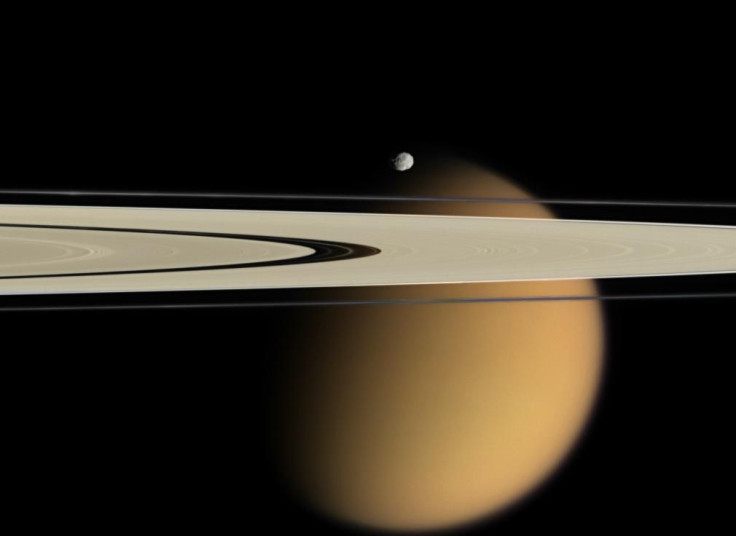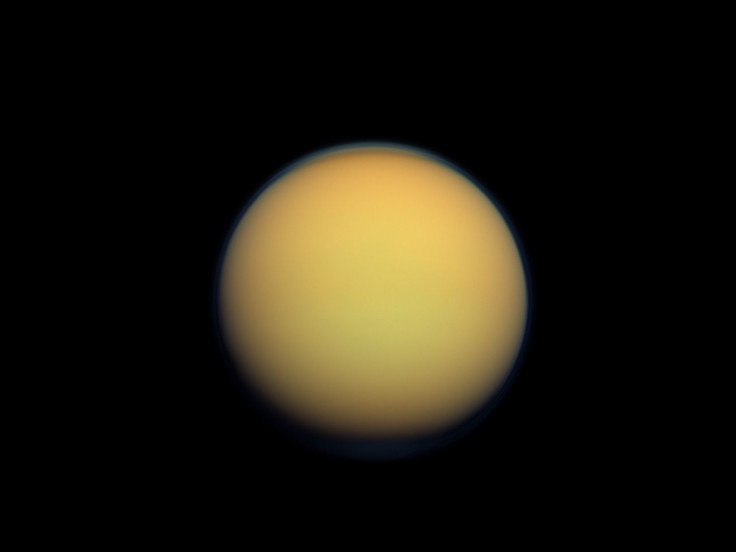It Rains On Saturn’s Moon Titan More Than Scientists Thought

It rains on Saturn’s moon Titan more than scientists thought, and the storms are intense.
A team of researchers has found that Titan sees a rainstorm less than once every 30 Earth years, but that’s still higher than previous estimates and could be enough to do some serious damage on the moon’s surface. On Titan, “the storms create massive floods in terrain that are otherwise deserts,” University of California, Los Angeles explained about the new findings. “Titan’s surface is strikingly similar to Earth’s, with flowing rivers that spill into great lakes and seas, and the moon has storm clouds that bring seasonal, monsoon-like downpours.”
Although Titan is the only other place in the solar system where liquid flows this way, the difference is that on Earth, it is water — on Titan, the flowing liquid is methane.
According to a study in the journal Nature Geoscience, the scientists used simulations of the conditions on Titan to observe how often and how hard it would rain on that moon, finding that “the most extreme storms tend to occur in the mid-latitudes,” which are at the centers of the northern and southern hemispheres. But all across the surface the storms are heavy enough to carry sediment and erode the surface, potentially changing Titan’s landscape over time — what the scientists refer to as “geomorphic work.”
Researchers have previously found evidence that features on the Titan surface could have been shaped by rainfall, a process that happens on Earth all the time. Closer to the equator, Titan tends to have huge sand dunes, while closer to its poles there are more lakes and seas. Large amounts of rain could lead to those lake and sea formations, while less rain would allow for the sand dunes. And those suspected rainfall differences between the poles and the equator are what the scientists observed in their simulations.
And when it rains, it pours.
“The most intense methane storms in our climate model dump at least a foot of rain a day, which comes close to what we saw in Houston from Hurricane Harvey this summer,” UCLA planetary scientist Jonathan Mitchell, the study’s senior author, said in the university statement.
It turns out that rainfall may influence the surface of Saturn’s largest moon much more than scientists previously estimated.
“I would have thought these would be once-a-millennium events, if even that,” Mitchell said. “So this is quite a surprise.”
Scientists have been learning more about conditions on Titan thanks to NASA’s Cassini spacecraft mission, which ended last month after several years exploring Saturn and its moons. Earlier this year astronomers studied the flow of liquid on Titan’s surface, determining that the moon’s rivers flow much more similarly to ancient rivers on Mars than to waterways on Earth. While the movement of tectonic plates have influenced our planet’s topography and the way rivers flow, including diverting them by changing the landscape, on Titan it is the gravitational pull of Saturn that creates changes in the crust that influences flow and Titan’s surface does not evolve as often as Earth’s. Researchers studying these rivers found that Titan’s system is more similar to what could have been found on Mars many millions of years ago.
Mars is believed to have been wetter, with a significant amount of rainfall, much earlier in its history, but it has dried up since the majority of its atmosphere was lost to space.
On Titan, UCLA explained, the “intense storms develop due to the sharp differences between the wetter, cooler weather in the higher latitudes and the drier, warmer conditions in the lower latitudes.” We see this sort of weather pattern on Earth when temperature differences help create storms in the mid-latitudes. The university said, “Greater understanding of the relationship between precipitation and the planetary surfaces could lead to new insights about the impact of climate change on Earth and other planets.”

© Copyright IBTimes 2025. All rights reserved.



















